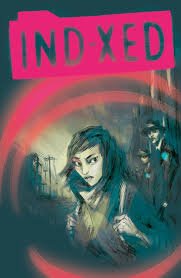Co-creator: Marinus Reininga
Co-creator and writer: Gilbert Deltrez
Artist: JL Giles
Call of the Void, November 2021
Why is H.P. Lovecraft so popular almost a century after he created his first work in the Cthulhu mythos? The text itself is often prolix, expository, and clumsy. The man himself was a horrible racist. Mr Lovecraft’s monsters dined on (female) virgins, suggesting something downstairs in Mr Lovecraft’s brain was more inappropriate even by the misogynistic standards of the day, rather than just merely dark.
The Guardian https://www.theguardian.com/books/2013/jun/03/hp-lovecraft-writer-out-time quotes American author Elizabeth Bear to explain Mr Lovecraft’s appeal:
“Because authors are read, beloved, and remembered, not for what they do wrong, but for what they do right, and what Lovecraft does right is so incredibly effective. He’s a master of mood, of sweeping blasted vistas of despair and the bone-soaking cold of space. He has at his command a worldview that the average human being, drunk on our own species-wide egocentrism, finds compelling for its sheer contrariness.”
(It also notes that Mr Lovecraft’s writing was “sometimes execrable“.)
Comic book writer and novelist Alan Moore told The Wall Street Journal in 2014 https://www.wsj.com/articles/BL-SEB-84058 :
“Lovecraft’s most enduring influence on my own work is the way in which, consciously or otherwise, he managed to imbue the familiar New England landscape that was so dear and immediate to him with a sense of the universe’s dispiriting vastness and the blind, random nature of the forces governing it, a perspective drawn from his keen interest in contemporary science and astronomy… As the familiar worlds around us are increasingly invaded by alien ideas, today’s writers could do worse than look to the strategies of antiquarian-modernist H.P. Lovecraft.”
This is an extended introduction to an independent title, Blackheart Manor, written by Marinus Reininga, co-created by Gilbert Deltrez, and with art by JL Giles. Together, the creative team saddle up a solidly Lovecraftian horror story of slowly accelerating creepiness, set in that time-honoured location, the haunted house. Because this is Lovecraftian, there is a lurking cult of hooded figures with twisting faces. But the plain antagonist is the abandoned, antiquarian building, Blackhart Manor, located on the outskirts of a fictional town called New Stockbridge. “Looks like Satan was conceived here,” says one of the characters, before discovering that his radio inexplicably does not work in the manor’s surrounds. “Sorry, but this place is right out of a Lovecraft book,” says another (a needless signpost to what is to come).
The manor, rotting and derelict, is destined for demolition, and the local fire department are given the opportunity to practice their skills by torching it. First, though, they must check for squatters. But the house is confusingly laid out. Unexpected breezes chill the necks of the characters. Frames depicting paintings and portraits are perceived differently by each member of the cast. The paintings are sometimes mirrors. Stairways curve into dark maws. Inexplicable forces tear at flesh, very “blind and random”. And at the very end we witness a betrayal, unexpected and sinister.

Here is the promotional copy from the Kickstarter campaign:
Plunge into a new, one-of-a-kind horror story, featuring a band of close-knit firefighters conducting a training drill at an antiquated manor that harbors a sinister primeval life force with a dark grudge. Inspired by the works of H.P. Lovecraft, Gilbert Deltrez and J.L. Giles bring you a tale that must be read to believe. This is… BLACKHART MANOR, a self-contained black & white 48-page one-shot. The second to a series of interconnected pulp horror-zine stories set in our Lovecraftian universe!
The characterisation is solid. The station chief laments his long disappeared daughter with palpable emotion. Hans and Bekka are likeable firefighters who do not deserve their inevitable fate. And Mr Giles’ art manages to dovetail the clean lines of the characters and their facial expressions with the miasmic scrawl of the manor and its inhuman mouths.

We commend the creative team of this title for engaging an editor, Jamie Johns. Writing a story like this runs the risk of being as over-the-top as Lovecraft was himself. A good editor pulls back the reins when necessary, digs in the stirrups in the long stretches, and objectively guides the team through the process of creation. Too many times we have read independently published comic books which lack that oversight. Creative teams do not hire editors because of a lack of money, or naivety, or an unwilling to share control of the labour of love. Blackhart Manor plainly does not have that deficiency.
Possibly the only significant deficiency about this publication is that it is in black and white. Of all the comics which would benefit from lurid and icky colours, this one is it.

